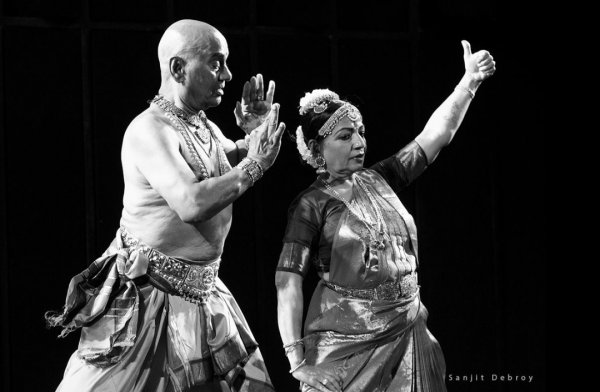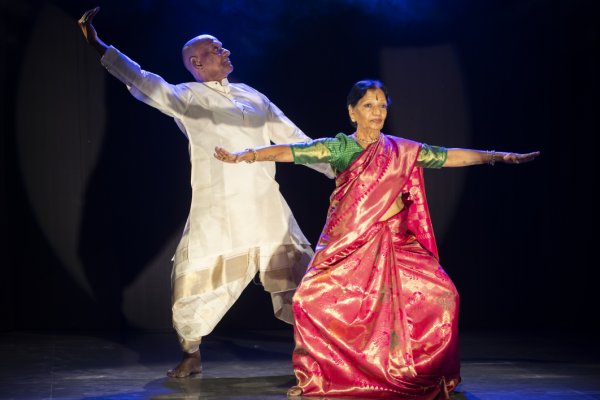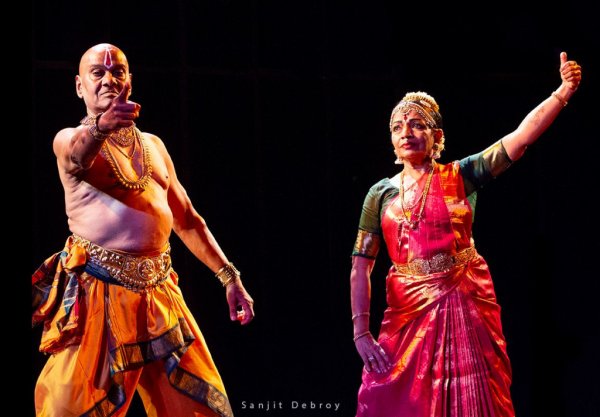
|
 |

|
 |
Raja Reddy: It is the duty of the Guru to create rasikas - Tapati Chowdhurie e-mail: tapatichow@yahoo.co.in December 5, 2022 I recently had an informal chat with Guru Raja Reddy during the 26th edition of their Parampara Festival at Delhi.  Raja and Radha Reddy What was the concept behind the presentation of your new choreography for the 26th Parampara festival? "Universe that is God" was inspired by Dr. Pandu Ranga Rao's book of the same name. It is an exploration of one's connection with universal one, which is crucial to maintain the balance of life on earth. Meditating to realize the Supreme spirit will help us understand how all life is interconnected with each other and ultimately how all life is connected to the one Supreme being manifested as 'Venkateshwara'. By meditating on 'Venkateshwara' one can try to understand the ultimate goal of life, marching towards something eternal, everlasting and inexplicable and what better way to do this than through dance and music. From the Vedic periods, ritualistic practices have been centered around engaging and enlightening people on to the spiritual path. These ritualistic practices with highly stylized gestural movements were usually accompanied by dance and music as an offering, 'Nritya Nivedana' such that through dance one can enter a meditative state similar to ritualistic chanting which can bring about an electronic change in the physical and metaphysical status of an individual. In the production we dealt with two major texts of Hindu religion, the Bhagavad Gita and the Vishnu Sahasranamam. Both texts belong to the same time period. While one text prepares us for poise and purposeful action, the other sums the good and bad effects of the action and prepares an outline for the establishment of peace amidst chaos and confusion. While the Gita is in the form of dialogue and the message is in complete sentences, the Sahasranamam is in the form of short and sweet names glorifying the splendid attributes and excellences of Vishnu reverberating with Vedic vibrations. Such that even if one does not know the real meaning of the names the chanting with correct articulation and intonation coupled with undivided attention produces vibrations in the mind, body and spirit which go a long way towards the realization of the soul. The production was conceptualized by Yamini Reddy. What lesson should the modern generation take from it? How would you relate the concept to a person as young as your grandson? The production was meant to bring an understanding of the universality of God. While we chose Lord Venkateshwara to put across this message through Kuchipudi dance, another individual may find his connection with universal being differently. The important point is to understand that all life on earth is interconnected through the Supreme Being. He resides in all of us and we reside in him. By understanding this concept of universality, we can perhaps understand and respect all life on earth and live in harmony on this planet.  Raja & Radha Reddy What is the significance of a Tarangam? What lesson do we learn from it? Tarangam means waves. Poets Narayana Teertha and Oothukadu Venkata Subbaiyyar - the devotees of Lord Krishna - wrote song after song like waves, that's how the name Tarangam has been given. The essence of dancing on the rim of a brass plate has a deep significance. The theme behind this dance is union of the individual soul with the supernatural soul. The dancer standing on the brass plate signifies her detachment from worldly affairs and her concentration is entirely on rhythm, song and music alone. The dancer's mortal soul that is Jeevatma merges with the supernatural soul or Paramatma. That is the essence of Tarangam. The tradition of Tarangam has been handed down since Vedic times. In Varahapuranam, the yogi who does penance facing many disturbances from the rain, thunder and lightning is the ultimate winner. In Varahapuranam, the yogi has been compared with the dancer, not the dancer with the yogi. So you can imagine how old this tradition of dancing on the rim of a brass plate is. How many years of practice is required for a performer to dance on a plate? After learning nritta items and nritya with abhinaya the dancer is ready to learn to dance on the rim of a brass plate. The piece needs rigorous sadhana with devotion, to produce the sound of the rhythmic syllables of the Nattuvanar and the mridangist on the plate. It takes at least two years of practice to dance with elan. What is the significance of drawing pictures of various gods and goddesses with your feet in Kuchipudi style of dance? The traditional Kuchipudi gurus don't do and don't teach drawing pictures of various gods with one's feet. We show the different Gods with hand gestures, hastha mudras only. What has been your memorable choreographic presentations for the Parampara Festival? We, Raja, Radha Reddy and Kaushalya Reddy were the first to present Natya Layavibhati, natyam combining six classical dance styles - Bharatanatyam, Odissi, Kathak, Mohiniattam, Manipuri and Kuchipudi dance. India is a land of diverse culture. People belonging to different religions, castes, communities live here in harmony. They share its rich cultural heritage with the spirit of oneness. "Ekam Sauraradharanam". We have conceived a unique presentation liked by those who had the opportunity to see it. We presented many demand shows. 'Natya Rasanubhuti' was another memorable dance drama which we had choreographed and this year our production was "Universe that is God" which got us a standing ovation during the 26th edition of our Parampara Festival. We have to go with the demands of the times. We take care with details like entry – pravesham - to the performing space; build up the theme to its climax and exit. Utilization of the entire stage with light effects is also very important.  Raja & Radha Reddy What are the changes in your choreographic work from the 80s to the present times? Kuchipudi dance is from Andhra Pradesh, the Telugu land. Telugu is the cultural language of south India. After coming to Delhi, we were presenting items and dance dramas in the Telugu and the Sanskrit language for many years. After seeing our performance, Dr. Shivarama Moorthy, founder of National Museum and a great scholar, advised us to choreograph items in the Hindi language too. We started choreographing Meera Bhajan pieces in the Rajasthani language and also in the Awadhi language from Tulsidas's Ramcharitmanas. We have used pieces from Urdu sahitya as well as Taranas from the works of Pt. Ravishankar which is in Hindustani style of music. Audiences all around the globe have invited us for these numbers time and again. We have also choreographed pieces in the English language written by Late A.P.J. Abdul Kalam, former President of our Bharat. How would you describe your style of Kuchipudi? Our Kuchipudi dance is "Natyam tannatakam chaiva pujyam poorva kathayutam." Our Kuchipudi natyam enacts stories, history of our country, mythological stories of Ramayanam, Bhagavatham, Shiva Leelas, Bhagavad Gita etc. not only to entertain people but to teach the present generation. Kuchipudi dance is a combination of Tandavam, Natanam, Natyam, Lasyam, Nrityancha, Nartanam. The way to learn our Kuchipudi dance and its perfection in technique one has to undergo rigorous practice in Adavus, Jathis, Mudras, Angasanchalan, Bhavam etc. What would be your advice to the aspirants of Kuchipudi? How would you draw and sustain the interests of youngsters who are academically good and will take up lucrative paying jobs but stay rooted to Kuchipudi? It is the duty of Gurus to be sincere to their art form If the gurus totally love what they are doing there is bound to be learners who will take to it and follow the footsteps of their guru. Only those who are passionate will stick to the form. It is the duty of the Guru to create rasikas. Kuchipudi has existed from time immemorial and will continue to do so in years to come. Contact Dr. Raja Reddy: reddy.art76@gmail.com  Tapati Chowdhurie trained under Guru Gopinath in Madras and was briefly with International Centre for Kathakali in New Delhi. Presently, she is a freelance writer on the performing arts. Post your comments Please provide your name and email id when you use the Anonymous / blog profiles to post a comment. All appropriate comments posted with name and email id in the blog will be featured in the site. |